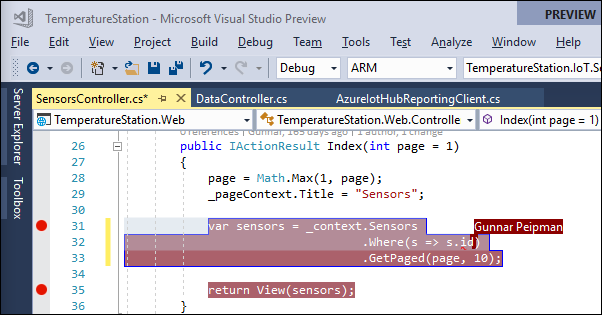Visual Studio Live Share enables you to collaboratively edit and debug with others in real time, regardless what programming languages you're using or app types you're building.
- C++ Visual Studio Mac
- Visual Studio Community For Mac
- Visual Studio For Mac Live Share
- Visual Studio For Mac Live Share Download
If you're not already familiar with Visual Studio Live Share, refer here for more information.
This extension pack includes everything you need to start collaboratively editing and debugging in real time, including integrated audio and text chat. This provides you and your team/class with a one-click installation, in order to begin pair programming, performing remote code reviews, driving interactive lectures, and more, without needing to leave Visual Studio Code.

Getting Started
- Real-time collaboration with Visual Studio Live Share. Whether your team is across the room or across the world, working together is easy with Visual Studio Live Share, installed with Visual Studio 2019. It’s available at the click of a button for many projects, app types, and languages.
- Hi, I'm a PM on the Visual Studio for Mac team. U/alashcraft is correct, we don't yet support Live Share. We are currently focused on improving more fundamental areas in the IDE including; code editor, debugging, performance, reliability, etc.
Install this extension pack and reload VS Code
Open your project, then click the
Live ShareMini paint brushes. button in your status bar to start a new collaboration session. Mysql connector/j. You'll be asked to login with your GitHub or Microsoft account the first time, which simply allows other developers to identify you.Refer to the Live Share quickstart for more details.
Open the Live Share
Sessions Detailsview, and click theStart audio call..node to start a call that is scoped to the guests in the sessionRefer to the Live Share Audio quickstart for more details.
A new document window, titled
Live Share Chat, will automatically open to the side. This window provides you with an integrated chat channel that is scoped to the guests in your collaboration session. If you close the window, you can always re-open it by clicking theChat Channelnode in the Live ShareSession Detailsview (as displayed below).Refer to the documentation for more details. Parallels desktop for mac pro edition.
When you send the VS Live Share link to another developer, they'll immediately join into your session, and will be prompted to connect to the audio call. From there, you can begin communicating and collaborating in real-time, without needing to rely on any other tools or services.
C++ Visual Studio Mac
Once you've collaborated with someone, they'll be automatically added to your Recent contacts list in the Live Share Contacts view (details). This allows you to see their real-time status (e.g. Available, Away, Do not disturb), send them instant messages, and then invite them into Live Share sessions, directly from the IDE. Collaboration couldn't be any easier!
To learn more about what you can do with VS Live Share (e.g. co-debugging, sharing terminals and localhost servers), refer to the comprehensive how-to guide.
Included Extensions
The following extensions are included as part of this extension pack, and therefore, will be automatically installed along with it:
| Extension | Stats |
|---|---|
| Live Share | |
| Live Share Audio |
Recommended Extensions
The following extensions aren't included as part of this extension pack, but are recommended based on the additional capabilities they provide to VS Live Share collaboration sessions (e.g. time-tracking, shared test runner, real-time code prototyping):
| Extension | Stats |
|---|---|
| Browser Preview | |
| CodeStream | |
| Code Time | |
| Discord Presence | |
| GitHub Pull Requests | |
| GitLens | |
| Live Server | |
| Live Share Pomodoro | |
| Live Share Spaces | |
| Live Share Whiteboard | |
| Peacock | |
| Test Explorer | |
| Quokka.js |
More Information
Installation

- Download Visual Studio Code for macOS.
- Open the browser's download list and locate the downloaded archive.
- Select the 'magnifying glass' icon to open the archive in Finder.
- Drag
Visual Studio Code.appto theApplicationsfolder, making it available in the macOS Launchpad. - Add VS Code to your Dock by right-clicking on the icon to bring up the context menu and choosing Options, Keep in Dock.
Launching from the command line
You can also run VS Code from the terminal by typing 'code' after adding it to the path:
- Launch VS Code.
- Open the Command Palette (Cmd+Shift+P) and type 'shell command' to find the Shell Command: Install 'code' command in PATH command.
- Restart the terminal for the new
$PATHvalue to take effect. You'll be able to type 'code .' in any folder to start editing files in that folder.
Note: If you still have the old code alias in your .bash_profile (or equivalent) from an early VS Code version, remove it and replace it by executing the Shell Command: Install 'code' command in PATH command.
Alternative manual instructions
Instead of running the command above, you can manually add VS Code to your path, to do so run the following commands:
Start a new terminal to pick up your .bash_profile changes.
Note: The leading slash is required to prevent $PATH from expanding during the concatenation. Remove the leading slash if you want to run the export command directly in a terminal.
Note: Since zsh became the default shell in macOS Catalina, run the following commands to add VS Code to your path:
Touch Bar support
Visual Studio Community For Mac
Out of the box VS Code adds actions to navigate in editor history as well as the full Debug tool bar to control the debugger on your Touch Bar:
Mojave privacy protections
After upgrading to macOS Mojave version, you may see dialogs saying 'Visual Studio Code would like to access your {calendar/contacts/photos}.' This is due to the new privacy protections in Mojave and is not specific to VS Code. The same dialogs may be displayed when running other applications as well. The dialog is shown once for each type of personal data and it is fine to choose Don't Allow since VS Code does not need access to those folders. You can read a more detailed explanation in this blog post.
Updates
VS Code ships monthly releases and supports auto-update when a new release is available. If you're prompted by VS Code, accept the newest update and it will get installed (you won't need to do anything else to get the latest bits).
Note: You can disable auto-update if you prefer to update VS Code on your own schedule.
Preferences menu
You can configure VS Code through settings, color themes, and custom keybindings available through the Code > Preferences menu group.
You may see mention of File > Preferences in documentation, which is the Preferences menu group location on Windows and Linux. On a macOS, the Preferences menu group is under Code, not File.
Next steps

Visual Studio For Mac Live Share

Once you have installed VS Code, these topics will help you learn more about VS Code:
- Additional Components - Learn how to install Git, Node.js, TypeScript, and tools like Yeoman.
- User Interface - A quick orientation around VS Code.
- User/Workspace Settings - Learn how to configure VS Code to your preferences settings.
Common questions
Why do I see 'Visual Studio Code would like access to your calendar.'
If you are running macOS Mojave version, you may see dialogs saying 'Visual Studio Code would like to access your {calendar/contacts/photos}.' This is due to the new privacy protections in Mojave discussed above. It is fine to choose Don't Allow since VS Code does not need access to those folders.
VS Code fails to update
If VS Code doesn't update once it restarts, it might be set under quarantine by macOS. Follow the steps in this issue for resolution.
Does VS Code run on Mac M1 machines?
Visual Studio For Mac Live Share Download
Yes, VS Code supports macOS ARM64 builds that can run on Macs with the Apple M1 chip. You can install the Universal build, which includes both Intel and Apple Silicon builds, or one of the platform specific builds.
